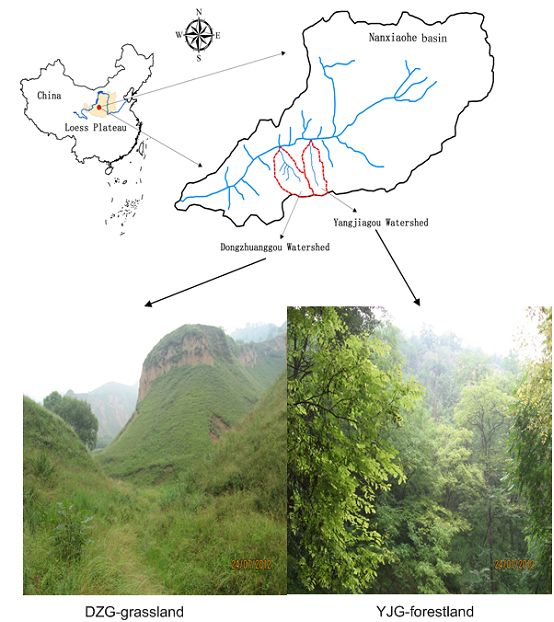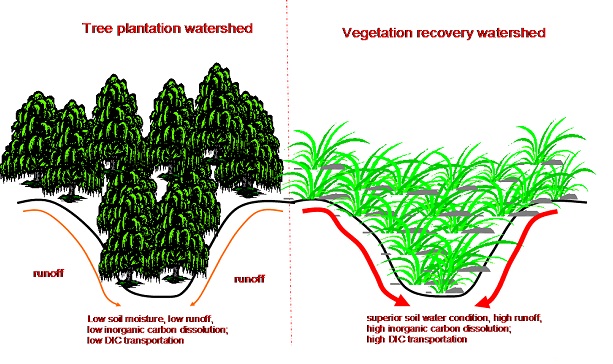Natural Vegetation Restoration is more Beneficial to Soil Surface Organic and Inorganic Carbon Sequestration than Tree Plantation on the Loess Plateau of China
The Loess Plateau of China is a unique geographical unit characterized byextensive loess distribution, serious soil erosion,low vegetation coverage, and high soil carbonate content. Since the 1950s, the Chinese government has made great efforts to control soil erosion and restore vegetation, including large-scale tree plantation in the 1970s, integrated soil erosion control in the 1980s and 1990s, and the “Grain for Green Project” in the 2000s. Currently, the ecological restoration of the Loess Plateau has produced remarkable achievements: an increase in vegetation coverage, a decrease in soil erosion, and an enhancement of ecosystem services. Soil carbon sequestration is a critical index for evaluating the efficiency of ecological restoration. Previous studies have unanimously indicated that ecological restoration significantly promotes soil carbon storage. However, most of these studies have focused on SOC, with only a few investigating SIC. The results of these studies show that the mean density and storage of SIC in the 0-100 cm soil layer on the Loess Plateau is more than twice that of the SOC pool and represents 21.66% of the total SIC storage inChina. Therefore, the SIC pool of the Loess Plateau may make an important contribution to the national carbon budget. Moreover, natural vegetation restoration and tree plantation are the two most important measures for ecosystem restoration. However, few studies have compared the effects of the two contrasting measures on SOC and SIC sequestration or have further used soil organic and inorganic carbon isotopes to analyze the inherent sequestration mechanism.
In our research, we examined two neighboring small watersheds on the Loess Plateau withsimilar topographical and geological backgrounds (Fig.1). Since 1954, natural vegetation restoration has been conducted in one of these watersheds and tree plantation in the other. The watersheds have now formed completely different vegetation landscapes (DZG: grassland; YJG: forestland). The objectives of our research were to (1) examine the difference in SOC and SIC sequestration between natural vegetation restoration and tree plantation and (2) identify the inherent mechanism of carbon cycling using soil organic and inorganic carbon isotopes method. According to a field investigation, we found that SOC storage was higher in the grassland than in the forestland, with a difference of 14.90 Mg ha-1. The vertical changes in the δ13CSOC value demonstrated that the two ecosystems have different mechanisms of soil surface organic carbon accumulation. The SIC storage in the grassland was lower than that in the forestland, with a difference of 38.99 Mg ha-1. The δ13CSIC values indicated that the grassland generates more secondary carbonate than the forestland and that SIC was most likely transported to the rivers from the grassland as dissolved inorganic carbon (DIC). The biogeochemical characteristics of the grassland were favorable for the formation of bicarbonate (Figure 2). Thus, more DIC derived from the dissolution of root and microbial respired CO2 into soil water could have been transported to the rivers through flood runoff. It is necessary to study further the transportation of DIC from the grassland because this process can produce a large potential carbon sink.

Fig. 1 Map showing the location of the study area in Xifeng District, Qingyang city, Gansu province, including the Dongzhuanggou (DZG) watershed and the Yangjiagou (YJG) watershed

Fig. 2 Difference in runoff and DIC transportation between the tree plantation watershed and natural vegetation recovery watershed
The research results were published in the journal of Science of the Total Environment (Jin Zhao, Dong Yunshe, Wang Yunqiang, Wei Xiaorong, Wang Yafeng, Cui Buli, Zhou Weijian. Natural vegetation restoration is more beneficial to soil surface organic and inorganic carbon sequestration than tree plantation on the Loess Plateau of China. Science of the Total Environment, 2014,485-486: 615-623).
The article online: http://www.ncbi.nlm.nih.gov/pubmed/24747253
 © 2015 Institute of Earth Environment,CAS
© 2015 Institute of Earth Environment,CAS  © 2015 Institute of Earth Environment,CAS
© 2015 Institute of Earth Environment,CAS